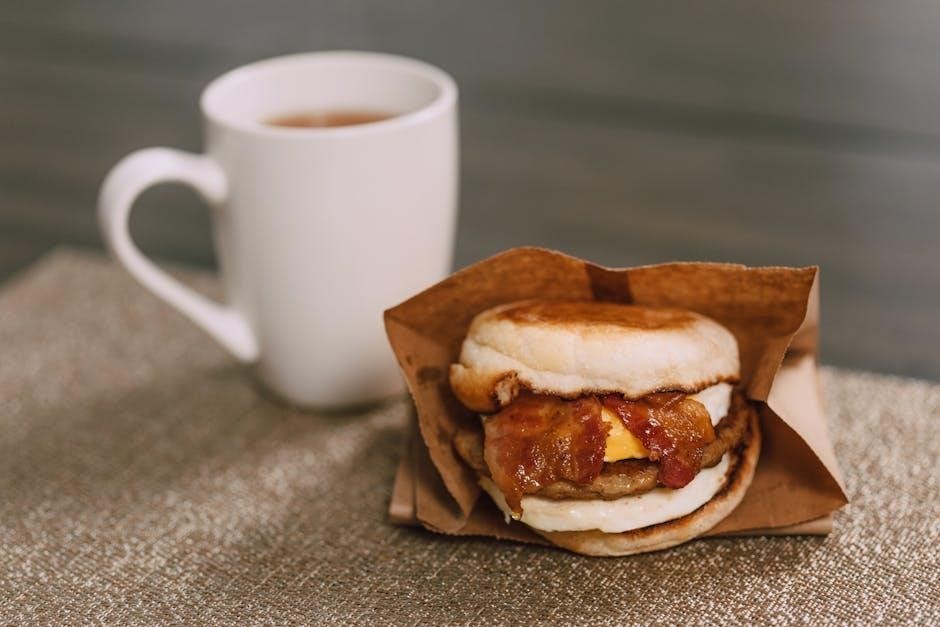The Dash Egg Bite Maker is a compact kitchen appliance designed for making delicious and nutritious egg bites quickly. It simplifies meal prep with one-touch cooking. Perfect for healthy lifestyles!

Setting Up the Dash Egg Bite Maker
Place the Egg Bite Maker on a stable, flat, heat-resistant surface. Preheating for 2-3 minutes before adding water speeds up the process, but it’s optional. Ensure it’s ready for use!
Placing and Preheating
Before diving into the delightful world of homemade egg bites, it’s essential to properly set up your Dash Egg Bite Maker. This ensures optimal performance and delicious results every time. Start by selecting a stable, flat, and heat-resistant surface in your kitchen. This will prevent any accidental tipping or movement during the cooking process, ensuring safety and even cooking. A countertop or sturdy table works perfectly. Next, position your Dash Egg Bite Maker on the chosen surface, making sure it has enough clearance from any nearby objects or walls. This allows for proper ventilation and prevents any potential heat damage. Once your Egg Bite Maker is securely placed, you have the option to preheat it. While preheating isn’t strictly necessary, it can significantly reduce the overall cooking time. To preheat, simply plug the appliance into a power outlet and allow it to heat up for approximately 2 to 3 minutes before adding water to the heating plate. This will give the heating element a head start, resulting in faster and more efficient cooking. Remember to always handle electrical appliances with care and follow the manufacturer’s instructions for safe operation. Now that your Dash Egg Bite Maker is properly placed and preheated (if desired), you’re ready to move on to the next step: preparing your ingredients and filling the cups for cooking. Get ready to create some mouthwatering egg bites!

Cooking Egg Bites: Step-by-Step Instructions
Follow these step-by-step instructions to create perfect egg bites using your Dash Egg Bite Maker. We’ll guide you through water measurement, filling cups, and cooking to perfection.
Water Measurement and Filling Cups
Accurate water measurement is crucial for achieving the ideal steam environment, ensuring your egg bites cook evenly and attain a soft, creamy texture. Typically, you’ll use the silicone cup provided with your Dash Egg Bite Maker to measure the water. Fill this cup to the designated line, usually indicated in the instruction manual. For standard models, this often means using one silicone cup of water. However, some larger models may require two cups. Always refer to your specific model’s manual for precise measurements. After measuring, carefully pour the water onto the heating plate. Avoid overfilling to prevent spillage.
Next, prepare your egg mixture. Whisk together eggs, shredded cheese, cottage cheese, salt, and pepper in a bowl or blender until well combined. This ensures a smooth and flavorful base for your egg bites. Now, it’s time to fill the silicone cups. Lightly spray the cups with cooking spray to prevent sticking. Pour the egg mixture into each cup, filling them about ¾ full. This leaves room for the eggs to expand during cooking. Add your desired ingredients, such as chopped vegetables, cooked meats, or herbs, distributing them evenly among the cups. Ensure the ingredients are finely chopped to facilitate even cooking.
Carefully place the filled silicone cups into the Dash Egg Bite Maker. Position them securely on the base. Once the cups are in place and the water is on the heating plate, you are ready to begin the cooking process.
Cooking Time and Process
Once the water is added and the silicone cups are filled, place the lid securely on the Dash Egg Bite Maker. Plug the appliance into a power outlet. The cooking process is initiated by pressing the power button. The appliance will begin to heat the water, generating steam. This steam is crucial as it cooks the egg bites uniformly, giving them that desirable silky texture. The typical cooking time for egg bites in a Dash Egg Bite Maker is approximately 7-10 minutes. However, this can vary based on the specific model and the ingredients used in your egg bite mixture. Always consult your Dash Maker’s instruction manual for the most accurate cooking times.
During the cooking process, monitor the appliance. The Dash Egg Bite Maker is designed to automatically shut off once the cooking cycle is complete. This feature prevents overcooking and ensures consistent results. You will know the cooking cycle is complete when the indicator light turns off. Once the cooking cycle is finished, unplug the appliance from the power outlet immediately for safety. Allow the egg bites to cool slightly before handling. This prevents burns and makes it easier to remove the egg bites from the silicone cups.
Carefully remove the lid, being mindful of any residual steam. Use a utensil to gently loosen the egg bites from the sides of the silicone cups. Invert the cups to release the egg bites. If they stick, try running a knife around the edges or gently tapping the bottom of the cup. Serve immediately and enjoy your delicious, homemade egg bites!

Cleaning and Maintenance
Proper cleaning ensures longevity. Always unplug and cool the Egg Bite Maker before cleaning. Thoroughly clean after each use. The non-stick surfaces and silicone cups are designed for easy cleanup!
Cooling and Cleaning Procedures
Before initiating any cleaning procedures, it is absolutely crucial to ensure that the Dash Egg Bite Maker has been completely unplugged from the power socket and has had ample time to cool down to a safe handling temperature. Attempting to clean the appliance while it is still hot or connected to a power source poses a significant risk of burns or electrical shock. Allowing the unit to cool completely not only ensures your personal safety but also prevents potential damage to the appliance itself. Rapid cooling with water, for instance, could warp or crack the heating plate or other components.
Once the Egg Bite Maker is cool to the touch, you can proceed with the cleaning process. Begin by disassembling any removable parts, such as the silicone cups. These cups are typically dishwasher-safe, but it is always recommended to consult the manufacturer’s instructions or the user manual to confirm. If you prefer to wash them by hand, use warm, soapy water and a non-abrasive sponge or cloth. Avoid using harsh scouring pads or abrasive cleaners, as these can scratch or damage the non-stick coating of the cups.
For the main body of the Egg Bite Maker, use a damp cloth to wipe down the exterior surfaces. Pay close attention to the heating plate, ensuring that any food residue or mineral deposits are removed. If necessary, you can use a mild detergent solution to help loosen stubborn stains. However, be careful not to get any water or cleaning solution inside the electrical components of the appliance. Never submerge the entire unit in water or any other liquid.
If you notice any mineral buildup on the heating plate, you can try using a solution of equal parts white vinegar and water to soak the affected area. Allow the solution to sit for a few minutes to dissolve the mineral deposits, then wipe clean with a damp cloth. Rinse thoroughly to remove any traces of vinegar.
Once all parts have been cleaned and rinsed, allow them to air dry completely before reassembling the Egg Bite Maker. Ensure that all components are fully dry before storing the appliance to prevent the growth of mold or mildew.
Regular cleaning and maintenance will help to keep your Dash Egg Bite Maker in optimal condition and ensure that it continues to produce delicious and perfectly cooked egg bites for years to come. By following these simple cooling and cleaning procedures, you can extend the lifespan of your appliance and enjoy hassle-free cooking every time.

Troubleshooting and Tips
This section addresses common issues encountered while using the Dash Egg Bite Maker, offering practical solutions. Additionally, it provides useful tips to enhance your cooking experience and achieve optimal results.
Common Issues and Solutions
Issue: Egg bites are not cooking evenly.
Solution: Ensure the Egg Bite Maker is placed on a stable, flat surface. Preheating can help with even cooking. Make sure the water level is correct, using the silicone cup for measurement. Distribute ingredients evenly in each cup. If using add-ins like cheese or vegetables, chop them into small pieces. Also, avoid overfilling the cups to prevent uneven cooking.
Issue: Egg bites are sticking to the silicone cups.
Solution: Lightly spray the silicone cups with cooking spray before adding the egg mixture. This helps prevent sticking and makes removing the egg bites easier. Ensure the egg bites are fully cooked before attempting to remove them. If they still stick, gently loosen the edges with a spatula.
Issue: The Egg Bite Maker is leaking water.
Solution: Make sure you are using the correct amount of water, as specified in the instructions. Overfilling the water reservoir can cause leakage. Also, check that the silicone cups are properly seated in the Egg Bite Maker. If the issue persists, inspect the heating plate for any damage or debris that may be causing a poor seal.
Issue: The Egg Bite Maker is not turning on.
Solution: First, ensure the Egg Bite Maker is properly plugged into a functioning power outlet. Check the power cord for any damage. If the appliance still doesn’t turn on, contact customer support for assistance, as attempting to repair it yourself could be dangerous.
Issue: Egg bites are too watery.
Solution: Reduce the amount of liquid in your egg mixture. If you are adding ingredients like vegetables, make sure they are not overly moist. Ensure the egg bites are cooked for the appropriate amount of time. Experiment with different cooking times to find the perfect consistency.
Issue: The metal lids are rusting.
Solution: If using lids, consider switching to plastic lids to avoid rust. Ensure the metal lids are completely dry before storing them. You can also try coating the metal lids with a thin layer of food-grade oil to prevent rust.
